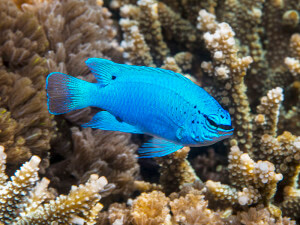
Fish Photography part 3: camera settings
Fish photography part 3. In the first two parts I discussed the importance of having good snorkeling skills and getting closer to your fish subject (parts 1 and 2, respectively). For this blog, I want to focus (pun intended) on the camera settings that generally lead to successful fish photos. And when I say successful fish photos, I mean sharp photos, and not necessarily the perfect ID or head shot (part 2 addressed composition where this will address focusing techniques).It is not a stretch to consider fish photography as ‘action’ or ‘sports’ photography. Because fish move (and move quickly), both you and the camera should be prepared for capturing a moving subject. If your camera has settings for adjusting shutter speeds and aperture, ideally you want high shutter speeds to freeze your subject. Low shutter speeds will often cause a blurred image and while this may be used to create abstract images, it is often not the desired result. Settings around 1/200 should be fine. Under bright light (either from the sun on clear days, or with a strobe), you could push it higher. If you cannot control your shutter speed (many point-and-shoot cameras do not allow this) then the camera can be set on ‘sports’ mode. Be careful that your camera will still allow a white balance setting for underwater when in sports setting, but also know that in post production on your computer, it is easier to adjust color temperatures than to fix a blurry image. Way easier.
Okay, so with a high shutter speed to capture crisp images you’re on the way. How about the focus? Given that most photos are taken with auto-focus, and that cameras have exceedingly responsive focusing mechanisms, this seems like the obvious route. Well, not necessarily. Remember that your camera wants to focus on a fixed subject and does not do well if the subject is moving in and out of wildly different planes of focus (e.g., it’s 1 meter away from the lens and now its 50 cm, and now its 70 cm). The auto-focus will constantly search for your subject and during the few seconds of opportunity you have to take the photo, the camera may still be focusing. This is especially appreciable when trying to photograph small fish that take up less than 50% of the lens’ field of view. In this case, the camera will often focus on the background rather than the subject.
One trick you can do is to put the camera into manual focus mode and set the plane of focus at a specific distance. After watching your subject and perhaps even making a few surface dives or approaches to see how close you can get, you can set the focus distance based on where you think the fish will likely be in relation to the lens. In other words, if you can get 30 cm without scaring the fish, then set the focal distance to about 30 cm. Aim your camera at a stationary subjects like coral or rocks and estimate about 30 cm. Lock the focus and then aim the camera at your fish. Allow the subject to swim into the plane of focus. I can’t tell you how much more successful you will be when you allow the fish to swim into your focal plane rather than chasing it with the auto focus. Your camera will also thank you as it will not have to be in a perpetual state of searching for a subject to focus upon! Thanks for reading my blog on fish photography part 3!


